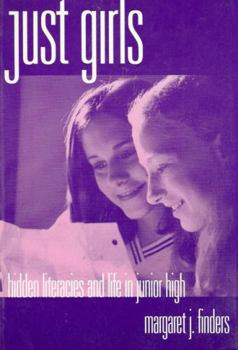Just Girls: Hidden Literacies and Life in Junior High
(Part of the Language and Literacy Series)
Select Format
Select Condition 
Book Overview
Just Girls is essential reading for teaching, teacher educators, parents, and anyone else interested in literacy learning and the social lives of adolescent girls.
Format:Paperback
Language:English
ISBN:0807735604
ISBN13:9780807735602
Release Date:June 1997
Publisher:Teachers College Press
Length:168 Pages
Weight:0.55 lbs.
Dimensions:0.4" x 6.1" x 9.0"
Customer Reviews
1 rating
Deeply felt academic research
Published by Thriftbooks.com User , 24 years ago
As an ethnography, Just Girls describes the literacies which provide means and vehicles for adolescent girls' expressions of their conformity and nonconformity to social codes and norms. Finders classifies the girls at the high school on the basis of social, economic and, to a lesser degree, behavioural characteristics. I suspect that the process of classification somewhat shaped the ethnographic report. Finders' use of language and her descriptions of the cookies and the queens frequently belie a bias in favour of the former and against the latter. Though this is helpful in truly bringing alive the power games that are played at the school, as well as justifiable to some degree, it was rather disturbing: the queens are, after all, young girls and not hardened, exploitative capitalists. The language used in some cases borders on the offensive: to take only one example, the queens "traveled in packs," like beasts of prey. She associates the queens' busy social lives with a severance of or distancing from parental ties. Finders appears to agree with Dottie's mother, who associates adolescent social activities with this distancing from one's family. I would not favour the queens' excessive preoccupation with social activities, and their inability to stand or speak alone; however, it is also difficult not to notice Finders' bias in favour of the traditional, "sensible," family-values sort of attitude of the cookies, which is juxtaposed with the air-headed, vacuous social fluttering of the queens. I think that to some extent, Finder's thesis - that the characteristics of adolescence are less a developmental stage than "ideological constructs that are fostered by the schedule and structure of the junior high school" (p.46) - is applicable in many situations, but ends up being stretched too far. I felt that there should have been somewhat more reflexiveness in Finders' account, and a little more uncertainty regarding her interpretations of what she observed. At the same time, one must acknowledge that through "rich description" and careful selection of circumstantial detail, Finders identifies what modalities align students with particular status groups: she shows how the cookies' inability to participate in co-curricular activities (because they do not have transportation) accords them low visibility and establishes them as low-status members of the school community. By and large, the social uses of literacy are emphasized; I would personally have also liked to explore the individual psyche of the girls further. It is fascinating to me how the queens use their cultural and linguistic literacy to establish status and power. They play with words and cultural images that are considered "out of the control of adolescents." It also serves to establish norms of "cool" which they apparently derive from popular culture, for which they are the custodians at school. As a teenager who never knew the cool thing to say,





